Co-Combustion of Blends of Coal and Underutilised Biomass Residues for Environmental Friendly Electrical Energy Production
Abstract
1. Introduction
2. Materials and Methodology
2.1. Feedstock Selection and Sample Preparation
2.2. Analysis of Coal and Biomass
2.3. Blending of Coal and Biomass on a Thermal Basis
2.4. Combustion and Flue Gas Emissions
3. Results and Discussion
3.1. Proximate and Ultimate Analysis
3.2. Flue Gas Emissions
3.3. Comparison of Emission Concentrations from Different Biomass Blending Ratios
3.4. Combustion Efficiency
4. Conclusions
Author Contributions
Funding
Data Availability Statement
Conflicts of Interest
References
- Islam Miskat, M.; Ahmed, A.; Rahman, M.S.; Chowdhury, H.; Chowdhury, T.; Chowdhury, P.; Sait, S.M.; Park, Y.-K. An Overview of the Hydropower Production Potential in Bangladesh to Meet the Energy Requirements. Environ. Eng. Res. 2020, 26, 1–13. [Google Scholar] [CrossRef]
- Li, M.; Luo, N.; Lu, Y. Biomass energy technological paradigm (BETP): Trends in this sector. Sustainability 2017, 9, 567. [Google Scholar] [CrossRef]
- Moogi, S.S.; Jae, J.; Kannapu, H.P.R.; Ahmed, A.; Park, E.D.; Park, Y.K. Enhancement of aromatics from catalytic pyrolysis of yellow poplar: Role of hydrogen and methane decomposition. Bioresour. Technol. 2020, 315, 123835. [Google Scholar] [CrossRef] [PubMed]
- Ansari, S.H.; Ahmed, A.; Razzaq, A.; Hildebrandt, D.; Liu, X.; Park, Y.-K.K. Incorporation of solar-thermal energy into a gasification process to co-produce bio-fertilizer and power. Environ. Pollut. 2020, 266, 115103. [Google Scholar] [CrossRef] [PubMed]
- Abu Bakar, M.S.; Ahmed, A.; Jeffery, D.M.; Hidayat, S.; Sukri, R.S.; Mahlia, T.M.I.; Jamil, F.; Khurrum, M.S.; Inayat, A.; Moogi, S.; et al. Pyrolysis of solid waste residues from Lemon Myrtle essential oils extraction for bio-oil production. Bioresour. Technol. 2020, 318, 123913. [Google Scholar] [CrossRef] [PubMed]
- Ahmed, A.; Abu Bakar, M.S.M.S.; Sukri, R.S.R.S.; Hussain, M.; Farooq, A.; Moogi, S.; Park, Y.-K.Y.-K. Sawdust Pyrolysis from the Furniture Industry in an Auger Pyrolysis Reactor System for Biochar and Bio-oil Production. Energy Convers. Manag. 2020, 226, 113502. [Google Scholar] [CrossRef]
- Jamil, F.; Aslam, M.; Al-Muhtaseb, H.; Bokhari, A.; Rafiq, S.S.; Khan, Z.; Inayat, A.; Ahmed, A.; Hossain, S.S.; Shahzad Khurram, M.; et al. Greener and sustainable production of bioethylene from bioethanol: Current status, opportunities and perspectives. Rev. Chem. Eng. 2020, 36. [Google Scholar] [CrossRef]
- Abdullah, A.; Ahmed, A.; Akhter, P.; Razzaq, A.; Zafar, M.; Hussain, M.; Shahzad, N.; Majeed, K.; Khurrum, S.; Bakar, M.S.A.; et al. Bioenergy potential and thermochemical characterization of lignocellulosic biomass residues available in Pakistan. Korean J. Chem. Eng. 2020, 37, 1899–1906. [Google Scholar] [CrossRef]
- Moogi, S.; Nakka, L.; Potharaju, S.S.P.; Ahmed, A.; Farooq, A.; Jung, S.C.; Rhee, G.H.; Park, Y.K. Copper promoted Co/MgO: A stable and efficient catalyst for glycerol steam reforming. Int. J. Hydrog. Energy 2020. [Google Scholar] [CrossRef]
- Ye, B.; Jiang, J.; Zhou, Y.; Liu, J.; Wang, K. Technical and economic analysis of amine-based carbon capture and sequestration at coal-fired power plants. J. Clean. Prod. 2019, 222, 476–487. [Google Scholar] [CrossRef]
- Oberschelp, C.; Pfister, S.; Raptis, C.E.; Hellweg, S. Global emission hotspots of coal power generation. Nat. Sustain. 2019, 2, 113–121. [Google Scholar] [CrossRef]
- Saidur, R.; Abdelaziz, E.A.; Demirbas, A.; Hossain, M.S.; Meklhilef, S. A review on biomass as a fuel for boilers. Renew. Sustain. Energy Rev. 2011, 2262–2289. [Google Scholar] [CrossRef]
- Ma, Q.; Cai, S.; Wang, S.; Zhao, B.; Martin, R.V.; Brauer, M.; Cohen, A.; Jiang, J.; Zhou, W.; Hao, J.; et al. Impacts of coal burning on ambient PM2.5 pollution in China. Atmos. Chem. Phys. 2017, 17, 4477–4491. [Google Scholar] [CrossRef]
- Guo, F.; Zhong, Z. Optimization of the co-combustion of coal and composite biomass pellets. J. Clean. Prod. 2018, 185, 399–407. [Google Scholar] [CrossRef]
- Xia, C.; Ye, B.; Jiang, J.; Shu, Y. Prospect of near-zero-emission IGCC power plants to decarbonize coal-fired power generation in China: Implications from the GreenGen project. J. Clean. Prod. 2020, 271, 122615. [Google Scholar] [CrossRef]
- Munir, S.; Nimmo, W.; Gibbs, B.M. The effect of air staged, co-combustion of pulverised coal and biomass blends on NOx emissions and combustion efficiency. Fuel 2011, 90, 126–135. [Google Scholar] [CrossRef]
- Ahuja, D.; Tatsutani, M. Sustainable energy for developing countries. Surv. Perspect. Integr. Environ. Soc. 2009, 2, 1–17. [Google Scholar]
- Ayub, H.M.U.; Park, S.J.; Binns, M. Biomass to syngas: Modified stoichiometric thermodynamic models for downdraft biomass gasification. Energies 2020, 13, 5383. [Google Scholar] [CrossRef]
- Ahmed, A.; Abu Bakar, M.S.; Hamdani, R.; Park, Y.K.; Lam, S.S.; Sukri, R.S.; Hussain, M.; Majeed, K.; Phusunti, N.; Jamil, F.; et al. Valorization of underutilized waste biomass from invasive species to produce biochar for energy and other value-added applications. Environ. Res. 2020, 186, 109596. [Google Scholar] [CrossRef]
- Chowdhury, T.; Chowdhury, H.; Ahmed, A.; Park, Y.K.; Chowdhury, P.; Hossain, N.; Sait, S.M. Energy, exergy, and sustainability analyses of the agricultural sector in Bangladesh. Sustainability 2020, 12, 4447. [Google Scholar] [CrossRef]
- Radenahmad, N.; Morni, N.A.; Ahmed, A.; Abu Bakar, M.; Zaini, J.; Azad, A. Characterization of rice husk as a potential renewable energy source. In Proceedings of the 7th Brunei InternationalL Conference on Engineering and Technology (BICET 2018), Bandar Seri Begawan, Brunei, 12–14 November 2018; pp. 1–4. [Google Scholar]
- Chowdhury, T.; Chowdhury, H.; Hossain, N.; Ahmed, A.; Hossen, M.S.; Chowdhury, P.; Thirugnanasambandam, M.; Saidur, R. Latest Advancements on Livestock Waste Management and Biogas Production: Bangladesh’s perspective. J. Clean. Prod. 2020, 272, 122818. [Google Scholar] [CrossRef]
- Pedersen, L.S.; Nielsen, H.P.; Kiil, S.; Hansen, L.A.; Dam-Johansen, K.; Kildsig, F.; Christensen, J.; Jespersen, P. Full-scale co-firing of straw and coal. Fuel 1996, 75, 1584–1590. [Google Scholar] [CrossRef]
- Ross, A.B.; Jones, J.M.; Chaiklangmuang, S.; Pourkashanian, M.; Williams, A.; Kubica, K.; Andersson, J.T.; Kerst, M.; Danihelka, P.; Bartle, K.D. Measurement and prediction of the emission of pollutants from the combustion of coal and biomass in a fixed bed furnace. Fuel 2002, 81, 571–582. [Google Scholar] [CrossRef]
- Akhtar, K.S.; Hussain, S.; Khan, R.U.; Ijaz, A. Thermochemical studies and fluidized bed combustion of low grade Pakistani coal blends. Life Sci. J. 2013, 10, 3358–3362. [Google Scholar]
- Nudri, N.A.; Wan Abdul Karim Ghani, W.A.; Thomas Bachmann, R.; Baharudin, B.T.H.T.; Ng, D.K.S.; Md Said, M.S. Co-combustion of oil palm trunk biocoal/sub-bituminous coal fuel blends. Energy Convers. Manag. X 2021, 10, 100072. [Google Scholar] [CrossRef]
- Xing, J.; Luo, K.; Wang, H.; Jin, T.; Cai, R.; Fan, J. A DNS study on temporally evolving jet flames of pulverized coal/biomass co-firing with different blending ratios. Proc. Combust. Inst. 2020, 38, 4005–4012. [Google Scholar] [CrossRef]
- Moon, C.; Sung, Y.; Ahn, S.; Kim, T.; Choi, G.; Kim, D. Effect of blending ratio on combustion performance in blends of biomass and coals of different ranks. Exp. Therm. Fluid Sci. 2013, 47, 232–240. [Google Scholar] [CrossRef]
- Wang, Y.; Liu, Y.; Yang, W.; Zhao, Q.; Dai, Y. Evaluation of combustion properties and pollutant emission characteristics of blends of sewage sludge and biomass. Sci. Total Environ. 2020, 720, 137365. [Google Scholar] [CrossRef]
- Standard Test Method for Moisture in the Analysis Sample of Coal and Coke; ASTM D3173/D3173M-17; American Society for Testing Materials: West Conshohocken, PA, USA, 2003.
- Standard Test Method for Volatile Matter in the Analysis Sample of Coal; ASTM-D 3175-07; American Society for Testing Materials: West Conshohocken, PA, USA, 2009.
- Standard Test Method for Ash in the Analysis Sample of Coal Coal; ASTM-D 3174-04; American Society for Testing Materials: West Conshohocken, PA, USA, 2010.
- Standard Test Method for Gross Calrorific Value of Coal; ASTM-D 5865-13; American Society for Testing Materials: West Conshohocken, PA, USA, 2009.
- Kim, S.S.; Kang, Y.S.; Lee, H.D.; Kim, J.K.; Hong, S.C. Characteristics of fundamental combustion and NOx emission using various rank coals. J. Air Waste Manag. Assoc. 2011, 61, 254–259. [Google Scholar] [CrossRef]
- Zan, H.; Chen, X.; Ma, J.; Liu, D.; Wu, Y. Experimental Study of NO xFormation in a High-Steam Atmosphere during a Pressurized Oxygen-Fuel Combustion Process. ACS Omega 2020, 5, 16037–16044. [Google Scholar] [CrossRef]
- Wang, C.; Wang, F.; Yang, Q.; Liang, R. Thermogravimetric studies of the behavior of wheat straw with added coal during combustion. Biomass Bioenergy 2009, 33, 50–56. [Google Scholar] [CrossRef]
- Froese, R.E.; Shonnard, D.R.; Miller, C.A.; Koers, K.P.; Johnson, D.M. An evaluation of greenhouse gas mitigation options for coal-fired power plants in the US Great Lakes States. Biomass Bioenergy 2010, 34, 251–262. [Google Scholar] [CrossRef]
- Kwong, P.C.W.; Chao, C.Y.H.; Wang, J.H.; Cheung, C.W.; Kendall, G. Co-combustion performance of coal with rice husks and bamboo. Atmos. Environ. 2007, 41, 7462–7472. [Google Scholar] [CrossRef]
- Lu, L.; Jin, Y.; Liu, H.; Ma, X.; Yoshikawa, K. Nitrogen evolution during the co-combustion of hydrothermally treated municipal solid waste and coal in a bubbling fluidized bed. Waste Manag. 2014, 34, 79–85. [Google Scholar] [CrossRef] [PubMed]
- Yang, X.; Luo, Z.; Liu, X.; Yu, C.; Li, Y.; Ma, Y. Experimental and numerical investigation of the combustion characteristics and NO emission behaviour during the co-combustion of biomass and coal. Fuel 2020, 287, 119383. [Google Scholar] [CrossRef]
- Su, W.; Ma, H.; Wang, Q.; Li, J.; Ma, J. Thermal behavior and gaseous emission analysis during co-combustion of ethanol fermentation residue from food waste and coal using TG-FTIR. J. Anal. Appl. Pyrolysis 2013, 99, 79–84. [Google Scholar] [CrossRef]
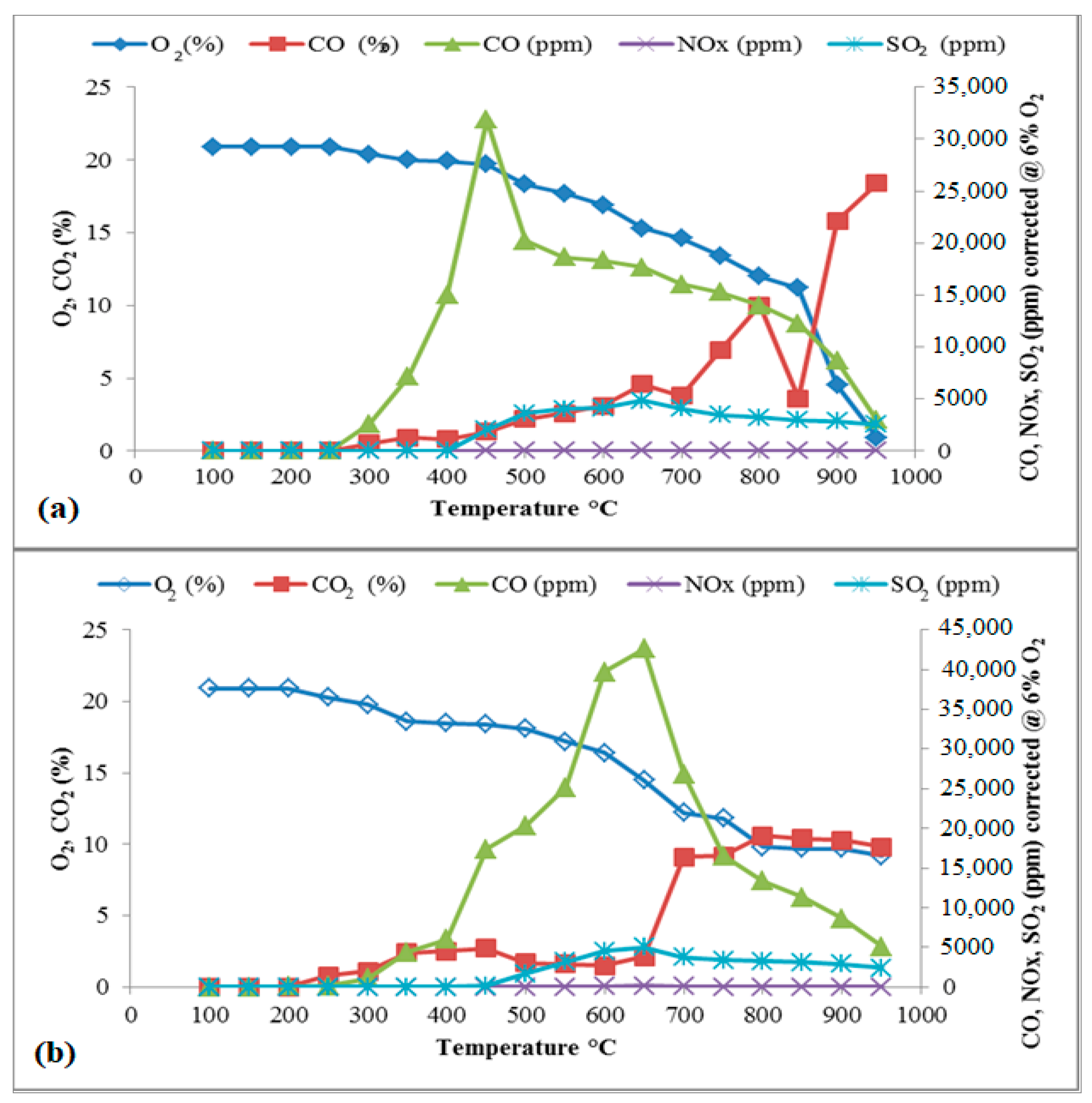

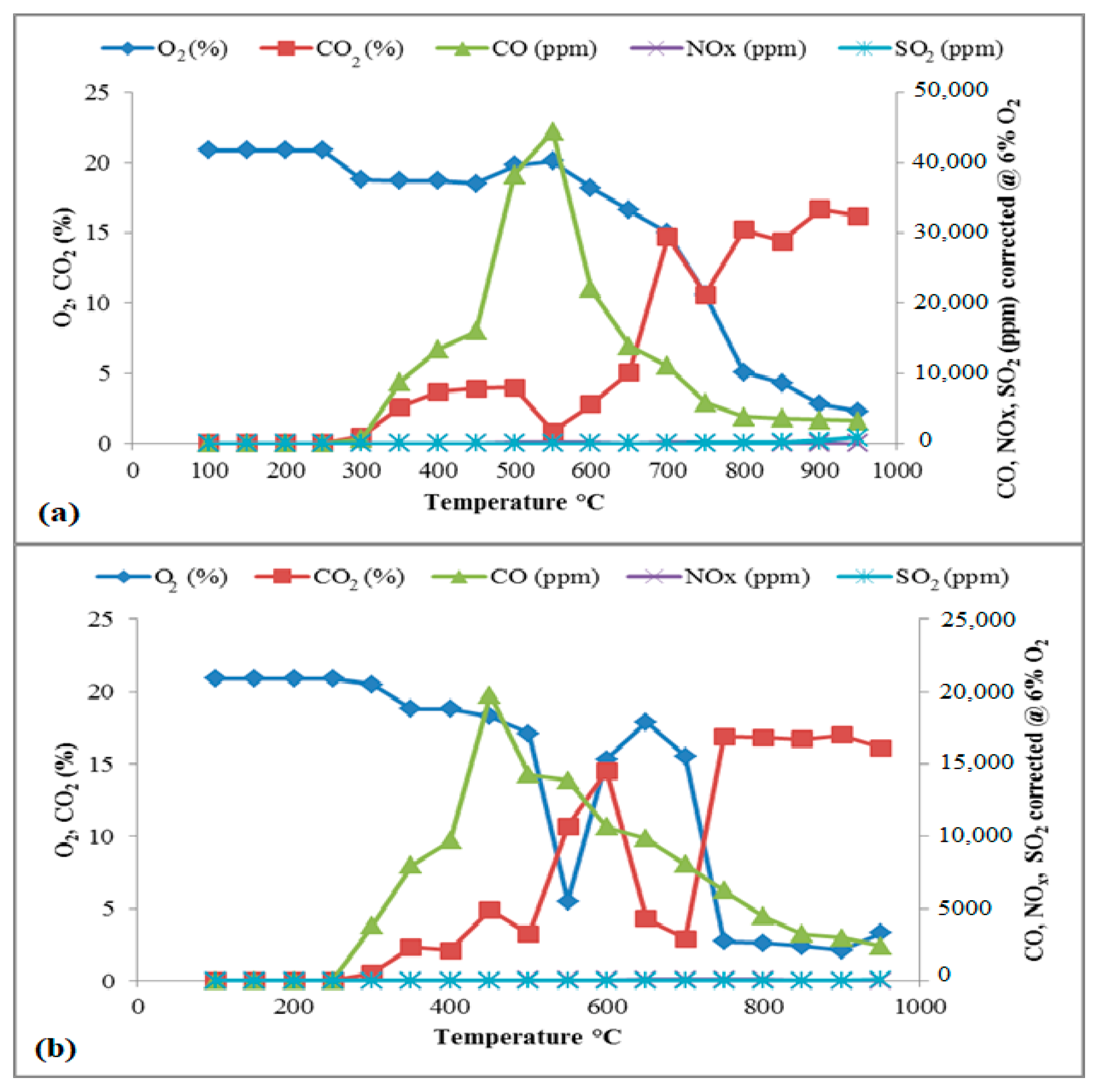

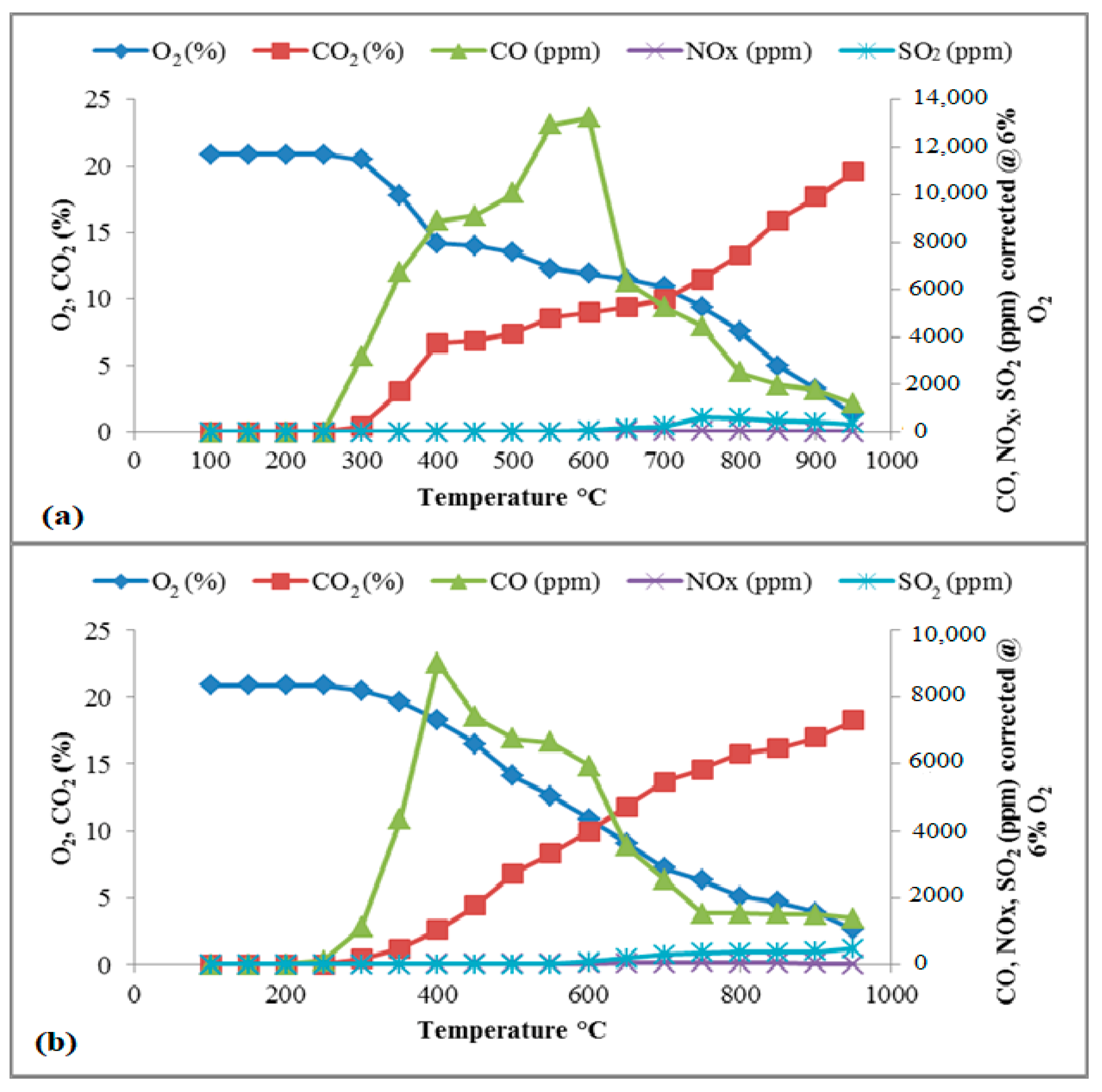
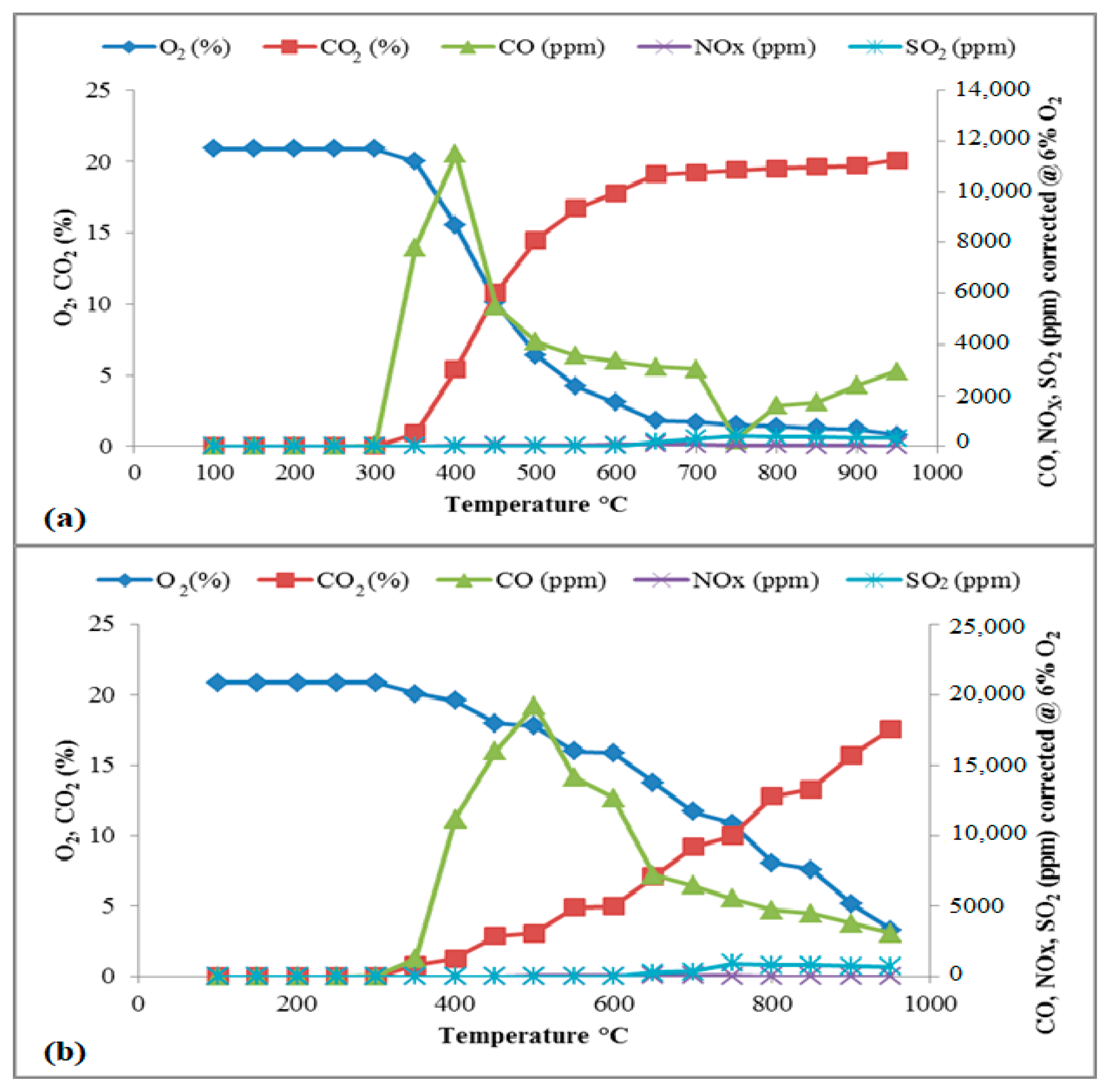
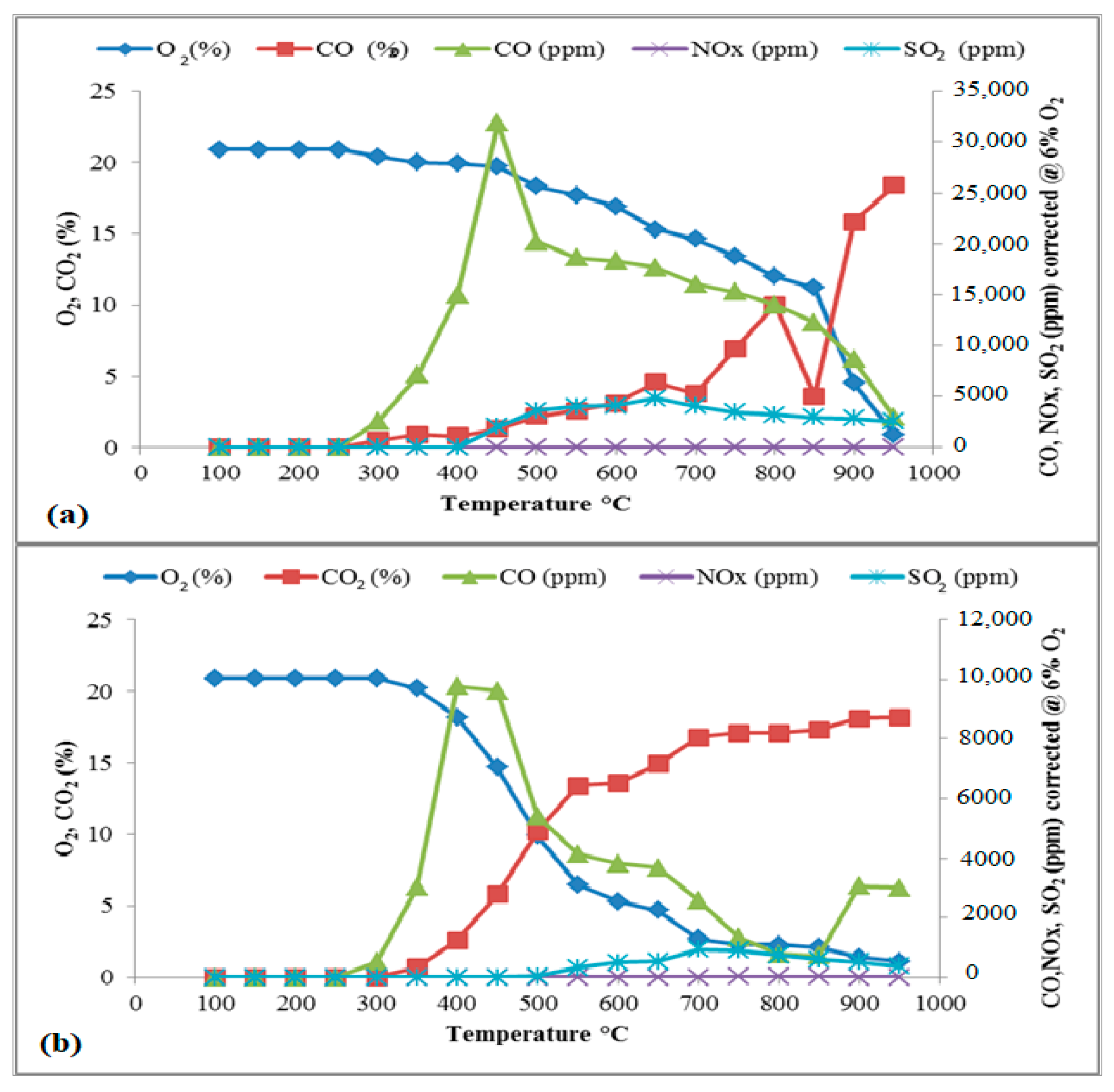
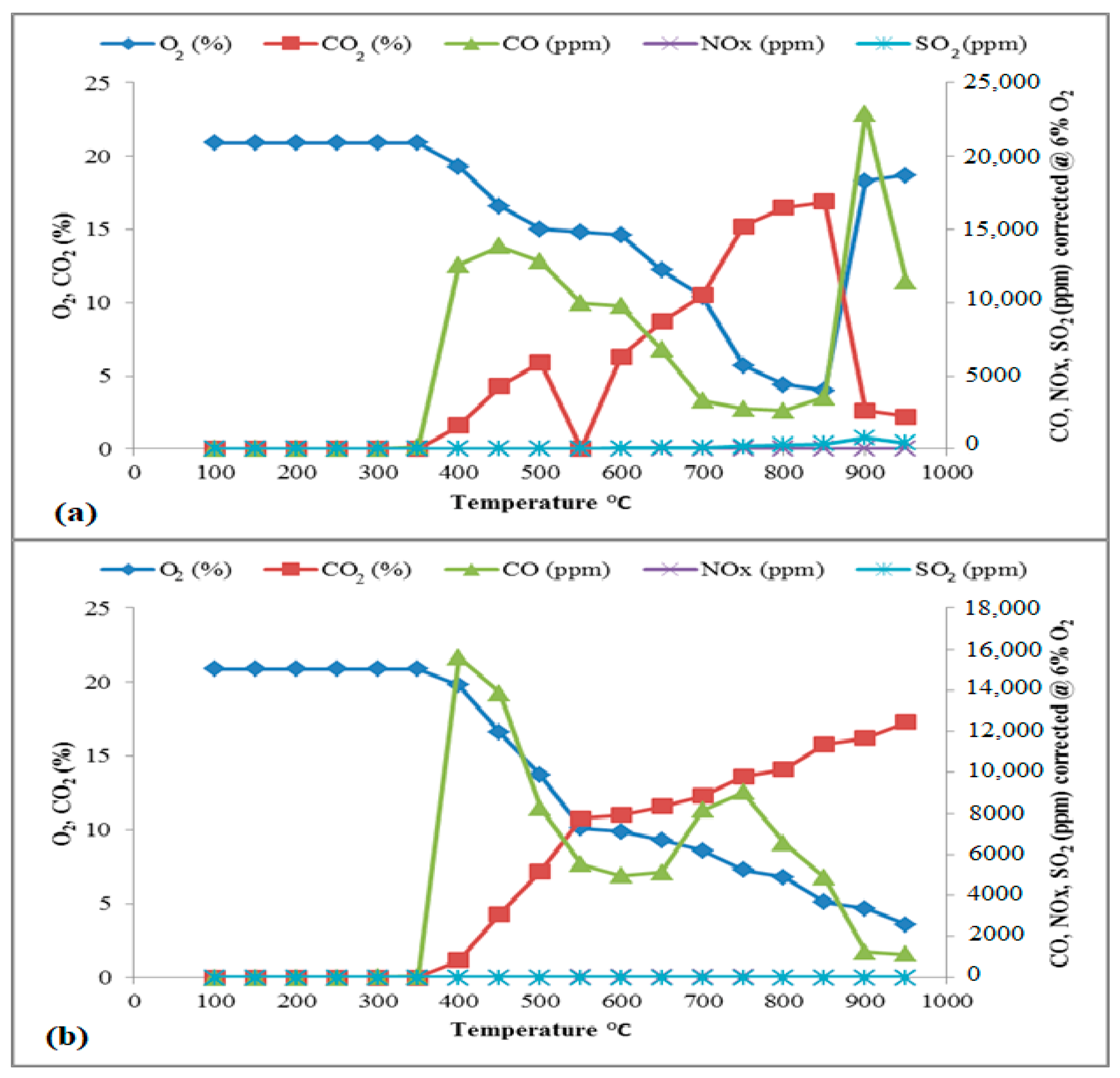
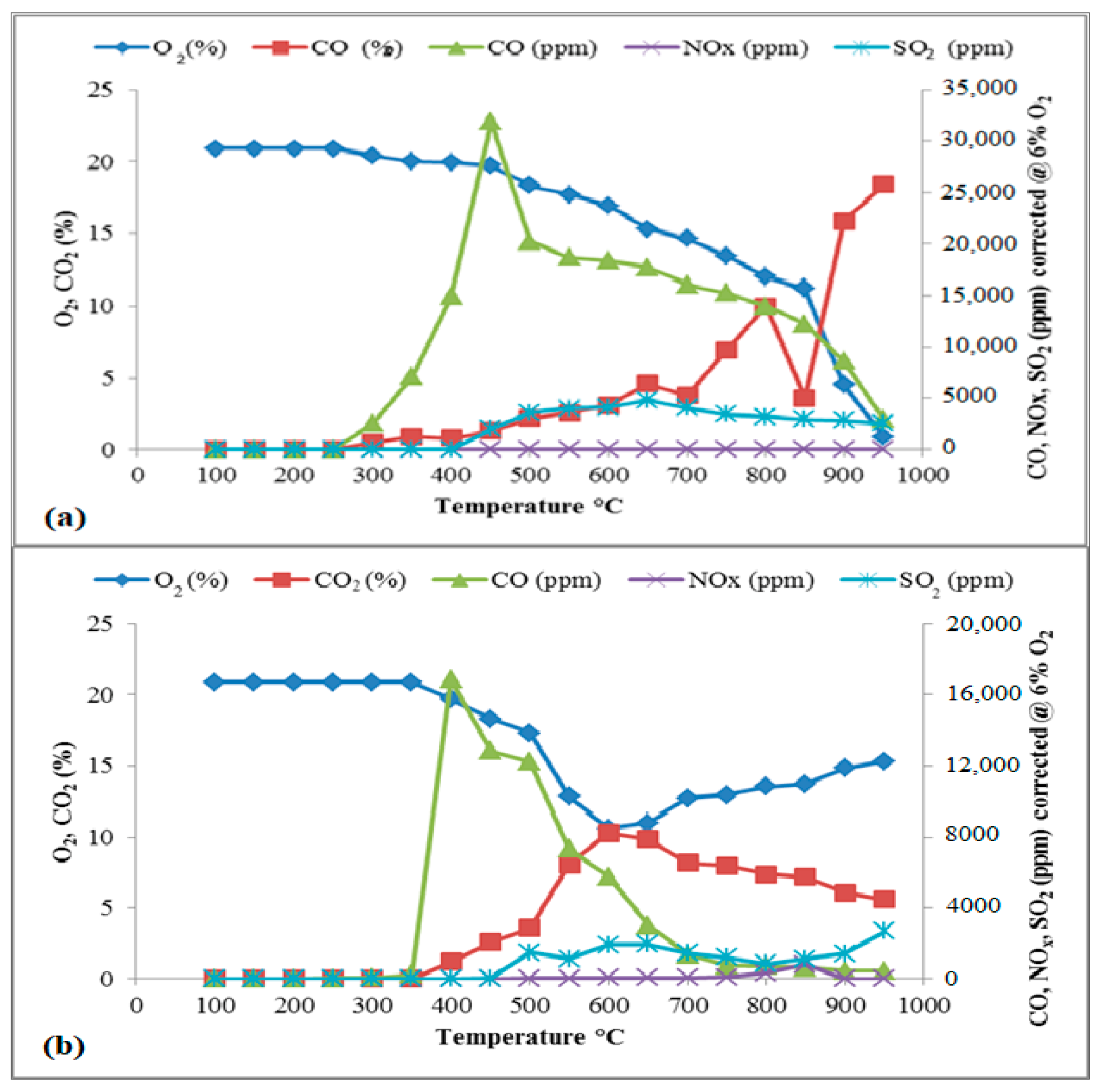
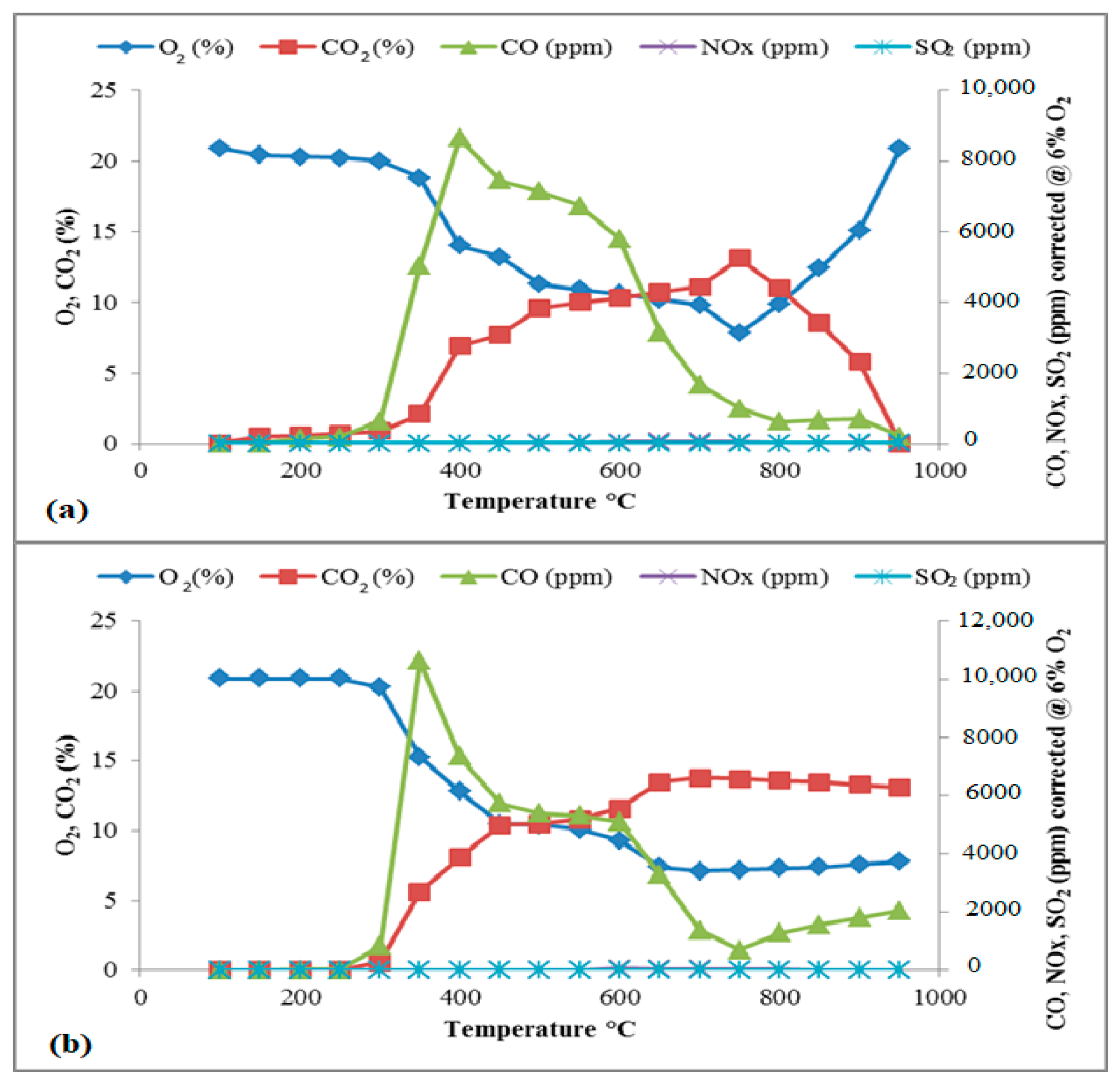
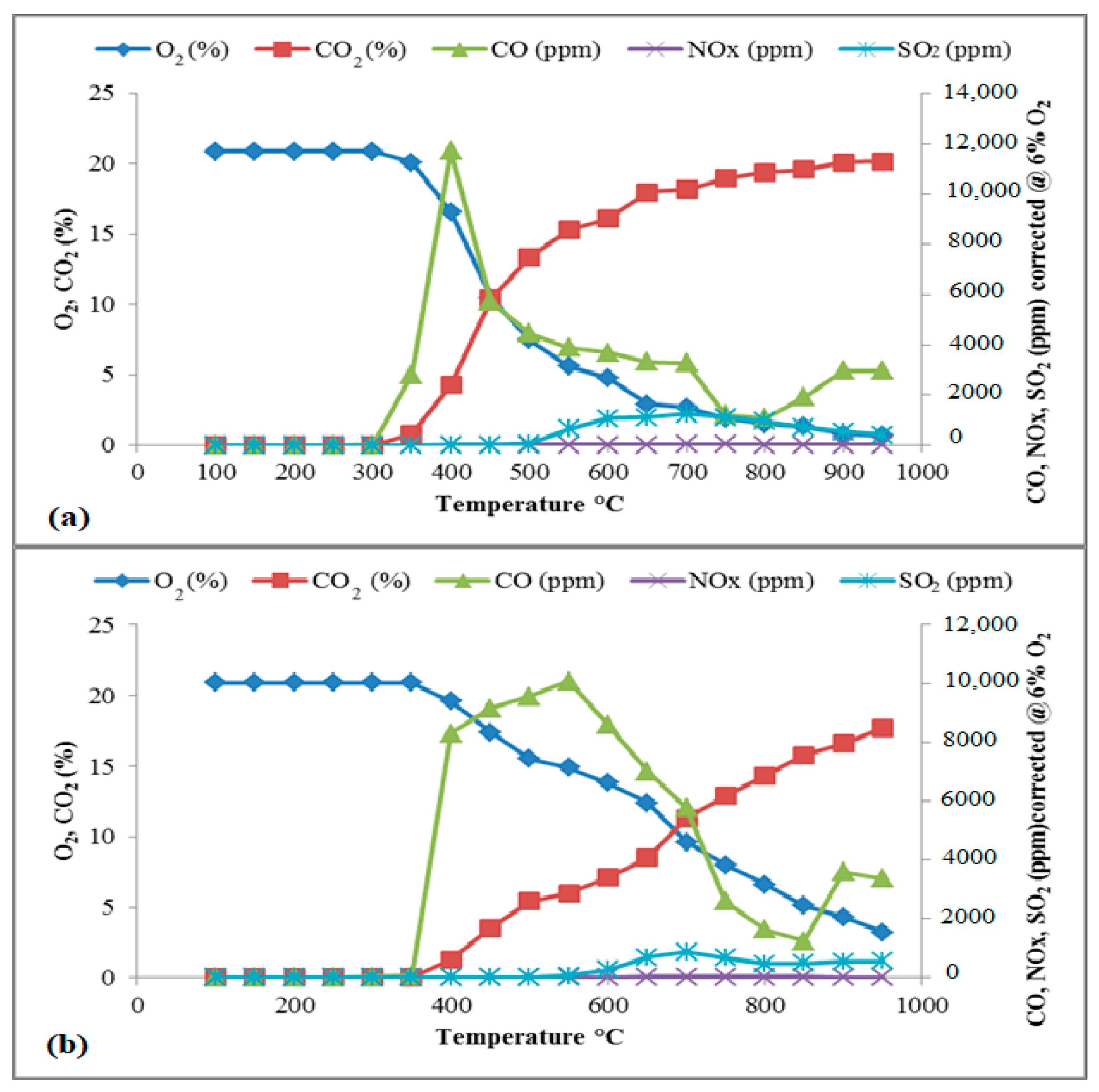
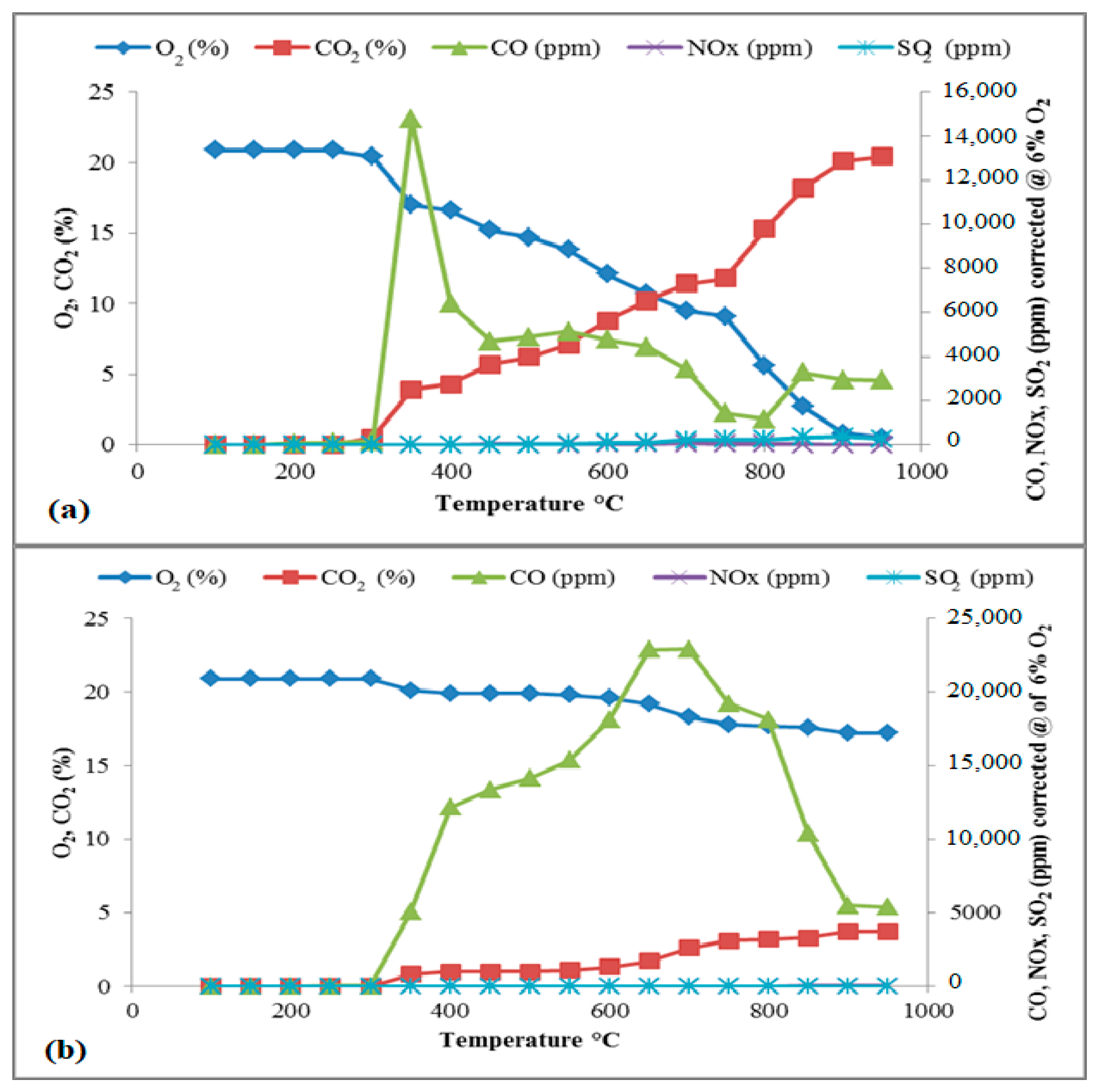

| Coal | Biomass | Coal and Poplar Sawdust (lit/min) | Coal and Rice Husk (lit/min) | Coal and Pine Nut Shell BBR (lit/min) | Coal and Sunflower Leftovers BBR (lit/min) |
|---|---|---|---|---|---|
| 1.44 (4.52:0) | 1.44 (4.52:0) | 1.44 (4.52:0) | 1.44 (4.52:0) | ||
| 90 | 10 | 1.34 (4.07:0.92) | 1.38 (4.07:0.76) | 1.37 (4.07:0.6) | 1.34 (4.07:0.83) |
| 80 | 20 | 1.31 (3.61:1.84) | 1.34 (3.61:1.53) | 1.33 (3.61:1.19) | 1.28 (3.61:1.66) |
| 70 | 30 | 1.27 (3.16:2.77) | 1.31 (3.16:2.29) | 1.30 (3.16:1.79) | 1.22 (3.16:2.49) |
| 60 | 40 | 1.22 (2.71:3.69) | 1.29 (2.71:3.06) | 1.26 (2.71:2.38) | 1.15 (2.71:3.32) |
| 50 | 50 | 1.16 (2.26:4.61) | 1.26 (2.26:4.61) | 1.23 (2.26:2.98) | 1.10 (2.26:4.14) |
| Proximate Analysis | Ultimate Analysis | GCV | |||||||
|---|---|---|---|---|---|---|---|---|---|
| Samples | Moisture (wt%) | Volatile Matter (wt%) | Ash Content (wt%) | * Fixed Carbon (wt%) | Carbon (wt%) | Sulphur (wt%) | Nitrogen (wt%) | * Others (H and O) (wt%) | (Kcal/Kg) |
| Poplar Sawdust | 4.76 | 80.95 | 4.72 | 9.57 | 36.30 | 0.32 | 0.27 | 63.11 | 3061 |
| Rice Husk | 5.40 | 58.46 | 18.00 | 18.14 | 48.80 | 0.31 | 0.35 | 50.45 | 3625 |
| Pine Nut Shell | 5.97 | 56.76 | 5.61 | 31.66 | 42.80 | 0.42 | 0.31 | 56.47 | 4620 |
| Sunflower leftovers | 3.86 | 71.84 | 17.64 | 6.66 | 30.10 | 0.31 | 0.38 | 68.79 | 3281 |
| Coal | 15.00 | 43.38 | 7.02 | 34.60 | 68.70 | 5.50 | 2.56 | 23.44 | 5587 |
Publisher’s Note: MDPI stays neutral with regard to jurisdictional claims in published maps and institutional affiliations. |
© 2021 by the authors. Licensee MDPI, Basel, Switzerland. This article is an open access article distributed under the terms and conditions of the Creative Commons Attribution (CC BY) license (https://creativecommons.org/licenses/by/4.0/).
Share and Cite
Kanwal, F.; Ahmed, A.; Jamil, F.; Rafiq, S.; Ayub, H.M.U.; Ghauri, M.; Khurram, M.S.; Munir, S.; Inayat, A.; Abu Bakar, M.S.; et al. Co-Combustion of Blends of Coal and Underutilised Biomass Residues for Environmental Friendly Electrical Energy Production. Sustainability 2021, 13, 4881. https://doi.org/10.3390/su13094881
Kanwal F, Ahmed A, Jamil F, Rafiq S, Ayub HMU, Ghauri M, Khurram MS, Munir S, Inayat A, Abu Bakar MS, et al. Co-Combustion of Blends of Coal and Underutilised Biomass Residues for Environmental Friendly Electrical Energy Production. Sustainability. 2021; 13(9):4881. https://doi.org/10.3390/su13094881
Chicago/Turabian StyleKanwal, Fariha, Ashfaq Ahmed, Farrukh Jamil, Sikander Rafiq, H. M. Uzair Ayub, Moinuddin Ghauri, M. Shahzad Khurram, Shahid Munir, Abrar Inayat, Muhammad S. Abu Bakar, and et al. 2021. "Co-Combustion of Blends of Coal and Underutilised Biomass Residues for Environmental Friendly Electrical Energy Production" Sustainability 13, no. 9: 4881. https://doi.org/10.3390/su13094881
APA StyleKanwal, F., Ahmed, A., Jamil, F., Rafiq, S., Ayub, H. M. U., Ghauri, M., Khurram, M. S., Munir, S., Inayat, A., Abu Bakar, M. S., Moogi, S., Lam, S. S., & Park, Y.-K. (2021). Co-Combustion of Blends of Coal and Underutilised Biomass Residues for Environmental Friendly Electrical Energy Production. Sustainability, 13(9), 4881. https://doi.org/10.3390/su13094881









